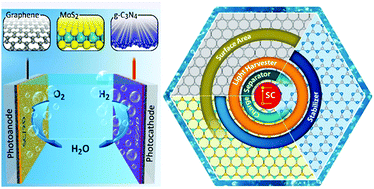Two-dimensional materials in semiconductor photoelectrocatalytic systems for water splitting†
Abstract
Hydrogen (H2) production via solar water splitting is one of the most ideal strategies for providing sustainable fuel because this requires only water and sunlight. In achieving high-yield production of hydrogen as a recyclable energy carrier, the nanoscale design of semiconductor (SC) materials plays a pivotal role in both photoelectrochemical (PEC) and photocatalytic (PC) water splitting reactions. In this context, the advent of two-dimensional (2D) materials with remarkable electronic and optical characteristics has attracted great attention for their application to PEC/PC systems. The elaborate design of combined 2D layered materials interfaced with other SCs can markedly enhance the PEC/PC efficiencies via bandgap alteration and heterojunction formation. Three classes of 2D materials including graphene, transition metal dichalcogenides (TMDs), and graphitic carbon nitride (g-C3N4), and their main roles in the photoelectrocatalytic production of H2, are discussed in detail herein. We highlight the various roles of these 2D materials, such as enhanced light harvesting, suitable band edge alignment, facilitated charge separation, and stability during the water splitting reaction, in various SC/2D photoelectrode and photocatalytic systems. The roles of emerging 2D nanomaterials, such as 2D metal oxyhalides, 2D metal oxides, and layered double hydroxides, in PEC H2 production are also discussed.



 Please wait while we load your content...
Please wait while we load your content...